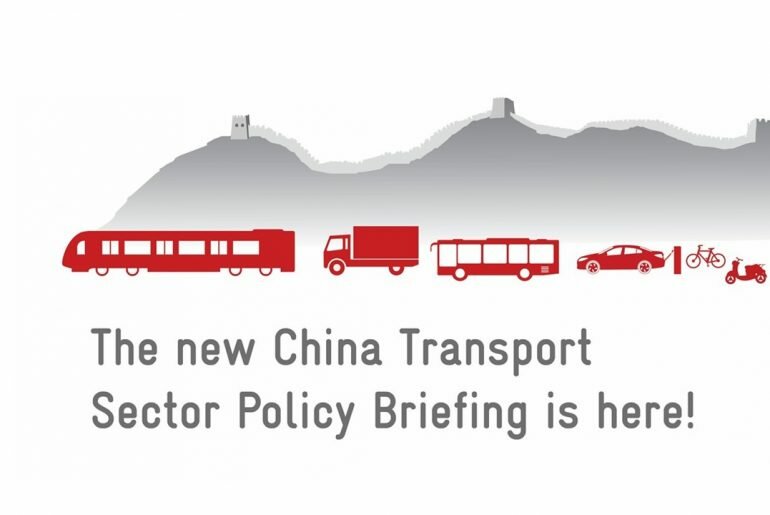China Transport Sector Policy Briefing – 2018, Issue 6
The newest issue of our China Transport Sector Policy Briefing is here! The Sustainable Mobility Team at GIZ in China provides you with regular summaries of new important policies in China’s transport sector.
Please click here to download: China Transport Sector Policy Briefing Issue 6 2018
In the end of 2018, the Chinese government started significant measures to advance its logistics industry, while planning to strengthen the hydrogen fuel cell production in Jiangsu. Furthermore, new developments regarding New Energy Vehicle (NEV) and Intelligent and Connected Vehicle (ICV) industries were omnipresent.
Reinventing the logistics industry, cleaner air for Beijing, intelligent ship building, battery recycling and hydrogen fuel cells
Beijing intends to aid the phase out of heavily polluting heavy duty vehicles (HDVs) in the capital city. Since 1 December 2018, CHINA III diesel-fueled HDVs registered in Beijing are no longer permitted within the city’s fifth ring road. And from 1 November 2019 onwards, all CHINA III diesel-fueled HDVs will be prohibited to enter the whole administrative area of Beijing, an area as large as Belgium.
Increasing e-commerce and an ever growing logistics industry are a huge burden for Chinese politics. In order to get control of this, on 21 December 2018, NDRC and MOT jointly released a new “National Logistics Hub Distribution and Construction Plan”, a three-step development plan for the Chinese logistics industry. The government aims to have built 30 modern national logistics hubs by 2020 and 150 by 2025, as well as to reduce logistics costs to under 12% of Chinese GDP. Until 2025, the proportion of freight turnover attributed to rail is to increase to 30%. Currently this lies at only 13% (2017) (in comparison: in Germany we are at 24%).
But also transportation by ship should increase under two conditions: it has to be clean and intelligent/ connected. Therefore, on 28 and 29 December 2018, MIIT consecutively released the “Action Plan on Intelligent Ship Development 2019-2021” and the “Action Plan on the Promotion of Intelligent Transformation of Ship Assembly and Construction 2019-2021” where clear targets and development goals for Connected Smart Ships (CSS) are set for the next three years.
In July 2018, MOT released its “Draft Adjustment Plan for the Shipping Emission Control Zone“. Obviously there has been quite a lot of feedback from stakeholders on this draft as the “Implementation Scheme of the Domestic Emission Control Areas for Atmospheric Pollution from Vessels” published by MOT on 10 December 2018 shows significant changes and less restrictions. From 1 January 2022 the sulphur content of any fuel oil used on board sea-going vessels should not exceed 0.1% m/m when operating in the coastal emission control area in Hainan waters. This date was previously set two years earlier, for 1 January 2020. Furthermore, from 1 January 2020, the sulphur content of fuel oil used on board sea-going vessels should not exceed 0.1% m/m when operating in inland river emission control areas. In the draft version this goal has been applied to all vessels on berth in sea emission control areas.
When it comes to intelligent and connected, of course, the automotive industry takes the lead. MIIT issued an Action Plan on the development of China’s ICV industry on 25 December 2018.
Also NDRC focuses on the further development and expansion of NEV and ICV industries. On 10 December 2018, NDRC announced the “Automotive Industry Investment Management Regulations”, which came into effect on 10 January 2019. With these regulations, NDRC intends to impose strict control on additional production capacity for vehicles with conventional engines. On the other hand, the regulation simplifies the approval of automobile investment projects and lays out project scopes in the areas of engines, batteries, battery recycling, vehicle assembly, special purpose vehicles and fuel cells.
Fuel Cells are also predominant in the city of Zhangjiagang, a city home to numerous hydrogen-related enterprises in Jiangsu province. On 24 December 2018, the “Three-Year Municipal Action Plan to Promote the Hydrogen Industry” has been published. By 2020, the annual output value of the hydrogen energy industry value chain in Zhangjiagang City is planned to exceed 10 billion RMB (ca. 1.3 billion EUR), out of which 1 billion RMB (ca. 130 million EUR) should be attributed to hydrogen production, 4 billion RMB (ca. 522 million EUR) to key components of hydrogen energy installations, 2 billion RMB (ca. 261 million EUR) to fuel cell systems and 3 billion RMB (ca. 392 million EUR) to fuel cell vehicles. The local government will provide financial subsidies for the construction of hydrogen stations, procurement of hydrogen-fueled vehicles, research and development on key component technology as well as the construction of public service platforms providing quality checks and certifications.
It is all about New Energy Vehicles! Aimed at implementing the “Interim Measures on the Management of Recycling and Utilization of New Energy Vehicle Power Batteries” and improving the recycling and utilization of NEV traction batteries in the Jing-Jin-Ji Region, the Beijing, Tianjin und Hebei governments jointly published the “Implementation Scheme for a NEV Traction Battery Recycling Pilot in the Jing-Jin-Ji Region” on 18 December 2018. The implementation scheme identifies targets for a Jing-Jin-Ji pilot on traction battery recycling. By 2020, the Jing-Jin-Ji region is to have a standardized, efficient and sustainable recycling system as well as a fair and competitive market environment. By 2020, a traction battery tracing system is to be established and able to trace the entire life cycle of each traction battery.
Sandra Retzer & the GIZ in China Sustainable Mobility Team







Comments are closed.